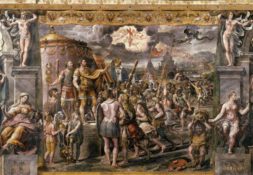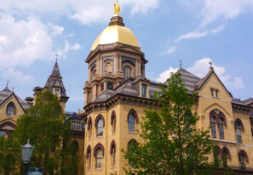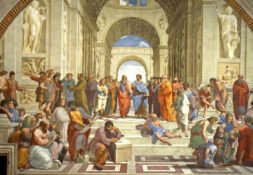By about the third day of trekking through English countryside, one comes to recognize the throbbing in the soles of one’s feet not so much as a pain but as an intense kind of feeling. A pilgrimage can effect that sort of subtle, gradual change in perspective. So, too, can it cause one to feel at peace, to feel a part of some grander order, or simply to feel.
If you had asked me a year ago, I certainly could not have foreseen myself spending Holy Week sleeping on church floors and parading along one-lane country highways with a cross fit for Golgotha. I would not have expected to see 10 varieties of roadkill or hear an Indian Jesuit scream “Eloi, Eloi, lama sabachtani!” in front of an altar. Even two weeks before setting off, I did not have much idea what I was getting myself into with the Oxford leg of the Student Cross pilgrimage. I envisioned some modern recreation of the Canterbury Tales, that is, a troupe of alternatively pious and rowdy pilgrims exchanging stories and never actually reaching their destination.
While not entirely inaccurate, my prediction missed the fact that Student Cross, understandably, consists of students carrying crosses to the Marian shrine in East Anglia rather than to Canterbury Cathedral. Like Chaucer’s Tales, though, the pilgrimage has some history to it, dating back to 1948 when an all-Catholic, all-male group set out to visit the shrine, restored only in the last 50 years after centuries of post-Reformation disuse (the Church of England in its infant years destroyed the shrine, but proceeded to rebuild it in 1922). The pilgrimage has diversified since then, expanding to 11 expeditions of men, women, and children of various Christian denominations all converging on Good Friday for the Easter Triduum in Walsingham, “England’s Nazareth.”
History, distance, duration—that is one way to think about a pilgrimage. Within the week of walking, though, the pilgrimage was simply experience, a joyous displacement from the bus-filled streets of bustling Oxford. I abandoned my sedentary reading in an isolated dorm room in favor of 8 hours a day of walking—praying while walking, talking while walking, taking my place beneath the cross which led us as it shifted from one trio of pilgrims to the next. I became definitively a part of a group of mutual dependencies, as we supported one another during the changing of the cross, so frequent and rhythmic such that it became its own meditative prayer.
We were 16 in number at the beginning of the week, but grew to 24 by Thursday to join a congregation of nearly 300 in Walsingham. Among us were Jesuits from France, India, Lithuania and Britain, Oxford students past and present, older couples and their children who have walked Student Cross their whole lives, a contingent of grammar school musicians from Manchester, bona fide lads, a municipal politician, a Methodist charity facilitator, a Madrid-based English teacher—all assembled to transport a cross some 120 miles. When I forgot about individualistic concerns, I began to participate, to become part of a body of many members, the Body of Christ.
This participation led to a twofold transformation. First, as we traversed similar dirt paths and passed field after field of sheep numbered with the same turquoise paint, I stopped anticipating the next tea stop or village marked by a lone church steeple. Rather than anticipating, I participated. I was wholly present, removed from past and future anxieties. It is odd. I expected to worry about all the work I ought to have been doing. I even brought a volume of German philosophy to work through (at night, while walking? When did I expect to have the time?). As much as I sweated during the day, not a bead was sweat for books that went unread. I never did open that philosophy volume.
Secondly, as ‘I’ became part of ‘we,’ our dependency on each other and the communities we passed through became clear. Generous parishioners offered us tea, cakes, and rest at each medieval church surrounded by a windswept churchyard with its jagged and lichen-spotted gravestones like a mouthful of stereotypical British teeth. We joined in prayer and song, shared meals together, provided blister block and bandages. Behind all this, though, dwelt something less material. Call it faith or charity, some gift of the Holy Spirit. A communal feeling of gratitude sustained us and drove us to Walsingham, where the greatest gift, Christ’s death and resurrection, centered our devotion.
No words can express the feeling of being on pilgrimage adequately. It is a feeling that demands participation, and as such must be experienced. One can say the same of most feelings, sure, but during a week of walking, the sensation settles in, footfall by footfall, until it inhabits every moment. While singing a hymn at a nightly prayer service, it occurred to me that faith operates like this, that it reconfigures experience part by part. The hymn was by Isaac Watts, and I had actually studied it in class. But by partaking in the hymn, by raising each word in song with a congregation of voices, the lyric took on new life. This moment among many presented a simple truth that this pilgrimage—as a literal answer to the call to take up one’s cross—presented best. Faith lives in participation. Faith is a way of life.
Charlie Ducey is a junior studying English and German. By fate and circumstance, he is marooned on a large island off the coast of Europe for the year. He can be contacted at cducey@nd.edu.





Leave a Reply